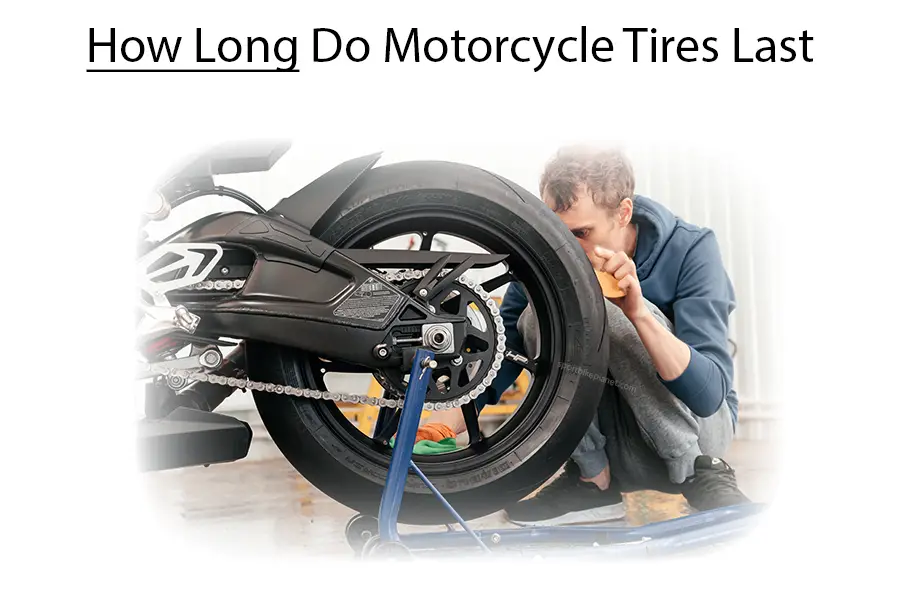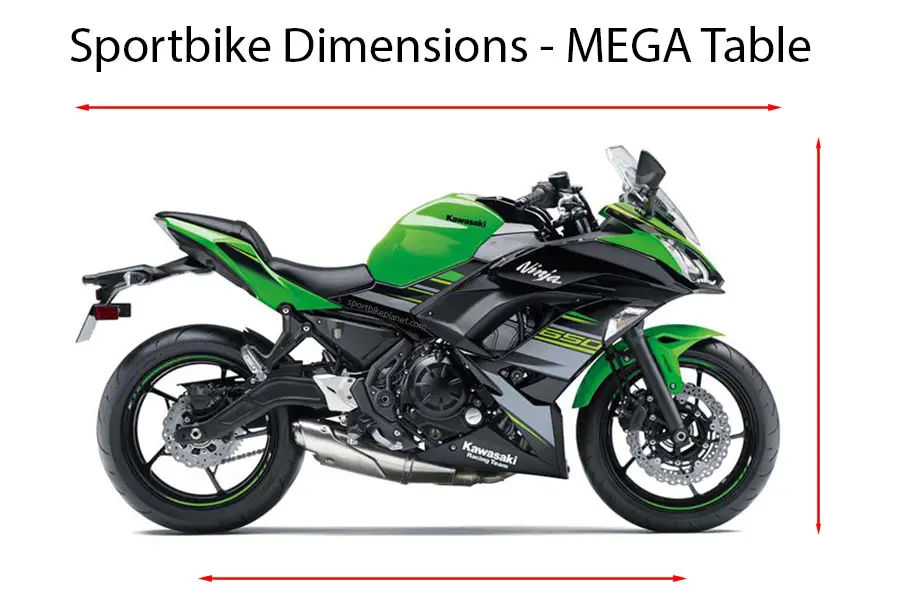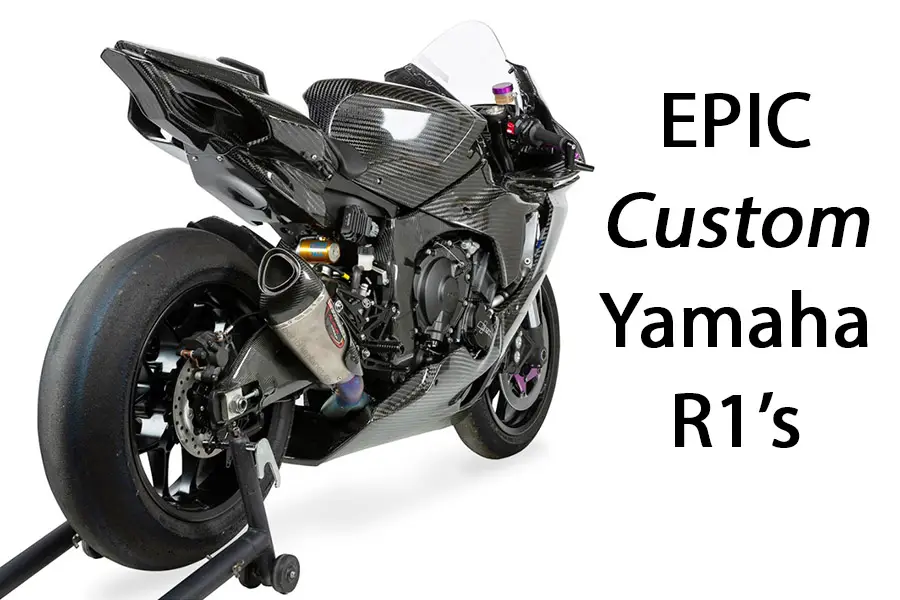Motorcycle tires, on average, have much less life in them than the car or truck tires most people are familiar with. You can get up to fifty to sixty thousand miles out of car tires depending on the compound, however motorcycle tires are not quite so long lived…
Motorcycle tires can last up to ten thousand miles and generally speaking this should be the expected upper limit. This lower tire longevity is due to motorcycle tires using a softer compound than car tires do. It should also be noted that motorcycle tire lifespan that will vary tremendously due to how, where a rider rides.
So how does one determine the life left in your tires?
Types Of Tires And Tire Life
At opposite ends of the tire range respectively are sportbike tires and touring bike tires, with the softer grippier sportbike tires being the shorter lived of the two.
Although we’re obviously primarily concerned with the sportbikes around here, having a look at the touring bike tires is informative for newcomers and relative novices in the tire replacement market.
Touring Tire Life
Tires designed for big eight hundred pound touring motorcycles are necessarily thicker and heavier to deal effectively with the load requirements of such a large machine, and will give you up to ten thousand miles of effective use.
The carcass construction includes much stiffer sidewalls and generally a far deeper tread depth. The primary intent is to support the weight of both the machine and two riders – we’re talking well over a thousand pounds for most, even for a solo rider.
The sideline benefit for owners of touring bikes is relative rubber longevity.

Michelin’s Commander III touring tires offer a claimed 25 percent longer tread life advantage over the company’s competitors – but is most assuredly not the correct choice for sportbike rubber. Source: www.michelinman.com
With proper care and feeding, that is, no punctures or road damage and run at the proper recommended inflation, touring tires can often last for up to ten thousand miles.
Sportbike Tire Life
Sportbike riders can typically get around three to four thousand miles out of their front tires, and sometimes a little less out of the rear tires. ven with proper maintenance and tire pressures this is significantly less than their touring bike tire counterparts.
This is because sportbike tires are built for performance, with a lighter carcass aimed at more traction and less heat.
They are designed and built with far softer rubber compounds with the intent of maximum traction while riding twisty turning roads (and sometimes tracks).
High mileage is simply not a priority to the manufacturer, and if you ride your sportbike with spirit and aggression, it shouldn’t be high on your list either.
Traction and grip is what it’s all about.
Further, with these softer rubber compounds coupled with the unfortunate fact that most roads aren’t all that twisty, a sportbike tire often will lose its profile and shape prematurely.

Pure sportbike tires like Michelin’s GP series offer maximum traction, but minimum longevity. They’ll stick like glue, but wear out the profile rapidly. Source: www.michelinman.com
The tire profile, or radius, is what allows you and your motorcycle to dive into turns with the assurance of maintaining traction while having the bike roll smoothly from side to side instead of tipping abruptly as you corner.
Yet, that same soft rubber that allows more aggressive riding also wears more aggressively, and the center of the tire will generally wear much faster than the rubber on the shoulders.
This is of course exacerbated if you have an inordinate propensity for straight-line acceleration. If you ride your machine more as a drag racer than a road racer, you’re going to go through a lot of rear rubber.
In any event, unless you exclusively take your sportbike to the race track for track days, you’re going to wear out the center tread before the shoulders.
And this fact is what made tire manufacturers
What Are Dual Compound Motorcycle Tires
A dual compound motorcycle tire is one where longer wearing compounds are used for the center section, with softer rubber compositions on either side for more grip when leaning over.
A great many tire manufacturers address tire wear issues by utilizing a dual-compound composition on their sportbike tire line.
This is tried, true, and effective. Still, you simply won’t achieve much more than a few thousand miles with bespoke sportbike tires.
Sport-Touring Tires
Sport-touring tires largely retain the same intent, construction, and profile of sportbike rubber, but are manufactured with harder compound compositions for increased longevity.
If you are strictly a recreational sportbike rider, meaning weekend rides on winding roads and the like, you’ll likely have the most satisfactory results from sticking to dedicated sportbike tires, particularly if you are well-skilled and sometimes ride aggressively.
However, if you spend most of your time riding on straighter roads or use your sportbike for commuting purposes (the horror!) then you could well benefit by going to a sport touring type of tire.

Michelin’s Pilot Road 4 GT sport touring tires offer excellent traction under wet and dry conditions, and might just be the sweet spot between performance and longevity for most riders. Source: www.michelinman.com
And for most riders, a sport touring tire will offer close to 90 percent as much performance while delivering something like 150 percent (or more) the longevity.
Are My Motorcycle Tires Too Old
Motorcycle tires that are more than five years old will not perform as well as fresher rubber. This is because tire rubber ages and hardens with time, and moreover with exposure to sunlight.
A motorcycle kept in a reasonably climate controlled garage will mean tires last appreciably longer than if your machine is regularly parked outside in a parking lot.
As mentioned before tires that are more than five years old will not perform as well as fresher rubber, however this involves another assumption, that we are talking about tires already mounted and in use.
Tires do have a pretty reasonable shelf life when simply sitting on a shelf, out of the sun, and not baking in a hot house.
Bottom line, when kept out of the sun, heat, and weather, motorcycle tires age fairly well.
Of course, this precludes actually mounting up tires, and then mounting up yourself to go for a spin.
Pretty hard to avoid sun and weather if you actually ride your bike.
If you have an older machine, or have recently purchased a previously owned sportbike, an oft overlooked facet of tire inspection is the date code stamped on the sidewall.
This date code is standardized by all reputable tire manufacturers.
Locate the four-digit code that shows the month and year of manufacture, for example, 1212 would indicate December of 2012, and also that you are in need of immediate tire replacement.
Ten years is the absolute maximum amount of life for a motorcycle tire irrespective of tread depth and wear and tear.
You do inspect your tires regularly, right? Well you should. Let’s talk about that.
Motorcycle Tire Inspection For Safety
Motorcycle tires should be checked regularly for damage and excessive wear. A serious rider, one who is serious about safety and his or her own longevity in addition to that of the tires, will regularly check for any cuts or cracks in either the tire tread or the sidewall area.
Punctures, of course, will reveal themselves.
Which brings us to proper inflation and tire pressure. Due to changes in temperature, atmospheric pressure, and other factors a tire that was properly inflated a month or more ago may or may not be properly inflated now.
Motorcycle tires certainly tend to lose pressure and not gain it when parked, so occasional riders should check their air pressure before every ride.
One way to do this is through the use of a handy portable tire pressure gauge like the one shown below.

Also, observe the manufacturer’s recommendations for inflation. While it is common for some sportbike riders partaking of track days to lower pressure readings for increased traction, that’s a seriously bad idea when riding on the street.
In addition to providing traction, your tires also protect more expensive components like your wheels from damage when inadvertently riding over a pothole or major crack in the pavement.
Finally, and extremely pertinent to sportbike tires, check your tread depth.
Not only for rubber remaining, but for consistency from the center of the tire to the sidewall tread.
If your tread is less than 1 millimeter deep, your tires are shot.
Moreover, if your tread is deeper on the sidewalls and shallower in the middle of the tire, which is all but inevitable at some point, your tire profile is compromised to some extent, as is how your sportbike handles when transitioning from a straight line into a corner.
Motorcycle Tire Purchase Considerations
If you’re still a fairly new rider, I’d recommend considering sport touring rubber as a cost-effective alternative to softer tires you don’t need and that will wear far more quickly.
Extremely importantly also is that tires should always be a matched set.
Each manufacturer designs front and rear tires with profiles that are matched for optimum performance.
Some tires have a very rounded profile which aids in predictability, while others are more triangular or pyramid shaped for quicker tip-in when cornering.
Whichever you might desire or prefer, a mismatched set of tires from two manufacturers can be a significant detriment to your motorcycle’s handling.
And lastly, for most street riders the rear tire will wear out more quickly than the front.
As long as you retain the correct front and rear match-up for the reasons stated above, replacing just one tire is an acceptable practise.
When the Rubber Meets the Road
Your tires do far more than keep your rims from getting scratched up, they are the primary component that keeps ’you’ from getting scratched up, or worse.
It can be extremely dangerous to run cracked, damaged, or patched tires on a motorcycle.
So keep the inspections up on your tires, keep an eye on the age of them, and remember that it’s money very well spent on replacing your tires with quality new ones if you have any concerns.




